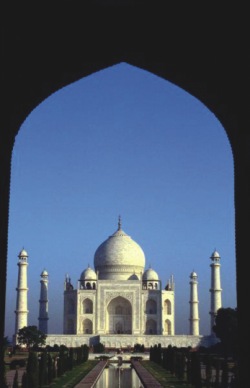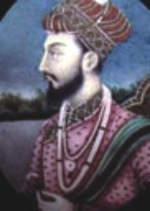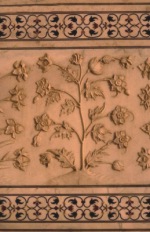Heritage
'Designed
by Giants and Finished by Jewelers': The Taj Mahal
 Imagine
the sight on a sun-scorched road leading to Agra. A ten mile
long parade of elephants and bull-drawn carts stretching off
into the rising heat on the horizon. Their load, the most
magnificent marble imaginable. Their destination, a construction
site on the banks of the glittering Jamuna river opposite
the city's Red Fort. Imagine caravans and fleets of ships
arriving from the far, far corners of the Mughal Empire. Their
cargo, an A-Z of gem stones. Turquoise from Tibet, yellow
amber from Burma, chrysolite from Egypt, lapis lazuli from
Budakhshan, nephrite jade and crystal from Turkestan, quartz
from the Himalayas and coral and pearl from the depths of
the blue, blue Indian Ocean, to name but a few. Within 22
years the marble and precious stones would become what is
now one of the wonders of the modern world: the Taj Mahal. Imagine
the sight on a sun-scorched road leading to Agra. A ten mile
long parade of elephants and bull-drawn carts stretching off
into the rising heat on the horizon. Their load, the most
magnificent marble imaginable. Their destination, a construction
site on the banks of the glittering Jamuna river opposite
the city's Red Fort. Imagine caravans and fleets of ships
arriving from the far, far corners of the Mughal Empire. Their
cargo, an A-Z of gem stones. Turquoise from Tibet, yellow
amber from Burma, chrysolite from Egypt, lapis lazuli from
Budakhshan, nephrite jade and crystal from Turkestan, quartz
from the Himalayas and coral and pearl from the depths of
the blue, blue Indian Ocean, to name but a few. Within 22
years the marble and precious stones would become what is
now one of the wonders of the modern world: the Taj Mahal.
Although
some scholars believe it was completed by the end of 1643
or early 1644, this year has been dubbed 'The Year of the
Taj Mahal,' and sees the celebration of the 350th anniversary
of its construction.
The plethora
of tourists visiting the site primarily remark on one thing:
it never looks the same. The wealth of shimmering gemstones
and jewels adorning its exterior render it ever changing in
colour as the sun draws across the sky and the moon rises.
The gleaming marble takes on hues of pinks, yellows and blues.
But due
to universal fear and anxiety caused by terrorist attacks
and the global war on terror, problems in the Middle East
and the increasing outbreaks of epidemics, people have become
wary and afraid. Tourism has dwindled worldwide and countries
relying on income created by the tourist dollar have, therefore,
suffered.
Nonetheless,
Indian Tourist Officials regard the anniversary of the Taj
Mahal as a chance to lure back tourists and with hotel bookings
already nearing 100 per cent, there are hopes that there will
be a huge leap in the 3.2 lakh foreign tourists that came
to Agra last year.
 The
next sixth months will see six 'mega-events' in the Uttar
Pradesh area organised by the Tourism Department. Last Monday,
clouds of heart-shaped balloons and white doves were released
into a suitably serene, pale blue sky. The day climaxed with
an evening concert at Agra Fort attended by 800 guests amongst
whom were a number of Bollywood stars. Bright orange garlands
of marigolds were handed out to tourists and two actors re-enacted
the love that led to the construction of the Taj Mahal itself. The
next sixth months will see six 'mega-events' in the Uttar
Pradesh area organised by the Tourism Department. Last Monday,
clouds of heart-shaped balloons and white doves were released
into a suitably serene, pale blue sky. The day climaxed with
an evening concert at Agra Fort attended by 800 guests amongst
whom were a number of Bollywood stars. Bright orange garlands
of marigolds were handed out to tourists and two actors re-enacted
the love that led to the construction of the Taj Mahal itself.
The reason
for its construction, however, is a sad one. Shahjahan, son
of Jahangir and 5th Mughal Emperor was deeply in love with
his wife. He and Arjumand Banu, a beautiful Persian Princess
met at the tender age of 15 and married after five years.
The princess, later known as Mumtaz Mahal, died 19 years later
after giving birth to their 14th child. On her death bed she
is reputed to have asked for four things of her devoted husband:
that he build her a tomb; that he visit this on the anniversary
of her death, that he remarry; and that he be kind to their
children. He honoured just two of her requests.
Construction
of the Taj Mahal began in the same year as the death of the
princess. Although there remains, even today, a certain lack
of clarity concerning exactly who designed and built the tomb,
it is commonly believed that the main artist was Isa, also
known as Ismail Khan, 'the builder of domes,' from Shiraz
in Iran. As if in testimony to the power of Shahjahan and
his empire, and mirroring the international make up of the
palace, other artisans included the sculptor Chiranjilal from
Delhi, Geronimo Veroneo from Italy, the French silversmith,
Austin de Bordeaux and two further Khans, Qazim the gold worker
from Turkey and Amanat the calligrapher also from Shiraz.
 It
is commonly believed that the amalgamation of Muslim and Hindu
architectural styles in the mausoleum was intended to represent
the Muslim idea of paradise. Moreover, there is evidence to
suggest that Shahjahan consulted, or at least was aware of,
an Islamic academic treatise which visually anticipated the
day of judgement. There are marked similarities between the
Taj Mahal and its gardens and the treatise that imply that
Shahjahan was attempting a replica of heaven on earth. It
is commonly believed that the amalgamation of Muslim and Hindu
architectural styles in the mausoleum was intended to represent
the Muslim idea of paradise. Moreover, there is evidence to
suggest that Shahjahan consulted, or at least was aware of,
an Islamic academic treatise which visually anticipated the
day of judgement. There are marked similarities between the
Taj Mahal and its gardens and the treatise that imply that
Shahjahan was attempting a replica of heaven on earth.
In addition
to the named architects who designed the building, some 20,000
Hindu artisans were also employed, which would account for
the numerous examples of Hindu iconography. Indeed it has
led some scholars to question the true origin of the Taj Mahal.
However, at the time, there was a stong integration between
the Muslim and Hindu cultures and the iconography of both
religions was often shared. It is also said that Shahjahan
inherited his love for the aesthetic from his uncle who frequently
blended the two styles in his own building projects.
But Shahjahan
was not as tolerant of Hindus as his uncle. Not only did he
raise land taxes on them to pay for the Taj Mahal, but it
is said that he had the fingers or hands of the artisans amputated
for fear that they might endeavour to replicate the splendour
of the monument elsewhere. This would have been scandalous
for the tomb was to remain, and does, unique in its glittering
magnificence.
Shahjahan
was an immensely wealthy and powerful (aren't all emperors!)
ruler. He had quashed rebellions and uprisings throughout
his corner of the Indian sub-continent and further expanded
the Mughal Empire. But he was also a fantastically vainglorious
man. His self appointed titles included the divine, 'Lord
of the Age,' 'Shadow of God,' and 'August representative of
God on earth,' and modern researchers even believe that he
viewed himself as a direct rival to God.
His military
campaigns and exuberance extended to Delhi the new capital
where he had had made, amongst other things, the renowned
Peacock Throne at an estimated expense of over five million
dollars (US) by today's standards. However, Shahjahan's penchant
for all things glittery quite literally broke the bank and
the hardships he imposed on Hindus made him increasingly unpopular.
It is believed that he was also about to embark on another
costly building project; a counterpart to the creamy white
monument of his adored Mumtaz--a black Mahal. Eventually it
was one of his sons, Aurangzeb, who, assuring his succession
as the 6th Shah by killing off his brothers, deposed Shahjahan,
incarcerating him at Agra Fort and thereby putting a stop
to his excesses.
 Legend
has it that he was only able to view his creation through
a mirror on the wall. However, it is more likely that he lived
in relative comfort inside the fort with all his new wives
and concubines and, in fact, would have been able to see the
Taj easily, albeit from a distance of 2 km. Shahjahan died
at the grand old age of 74, having overdosed on a particularly
potent aphrodisiac--sources are still unsure what--and he
was laid to rest inside the Taj next to his beloved. Legend
has it that he was only able to view his creation through
a mirror on the wall. However, it is more likely that he lived
in relative comfort inside the fort with all his new wives
and concubines and, in fact, would have been able to see the
Taj easily, albeit from a distance of 2 km. Shahjahan died
at the grand old age of 74, having overdosed on a particularly
potent aphrodisiac--sources are still unsure what--and he
was laid to rest inside the Taj next to his beloved.
Over the
years the mausoleum has become irreparably harmed by increasing
pollution levels and general wear and tear. The marble is
becoming stained and losing its lustre and in 1996 it was
damaged when a concert was held there. The Indian Supreme
Court has also put a stop to the mausoleum remaining open
at night because it would require floodlighting which would
further tarnish the marble.
The
irony is that the Taj Mahal has come to be not only a unifying
symbol of Islam and Hinduism but also an emblem of India.
Its gleaming whiteness adorns the covers of coffee table books
and guidebooks alike and around the world 'Taj Mahal' has
become synonymous with all things Indian be it curry houses
and naan bread or silk and saffron. In fact, its
very existence may have crippled the Indian, or Mughal, economy
short-term but it has done more for the tourist infrastructure
in India of the last 40 years or so than Aurangzeb would have
dared imagine. Here's to another 350 years.
Lally
Snow
Copyright
(R) thedailystar.net 2004
|
